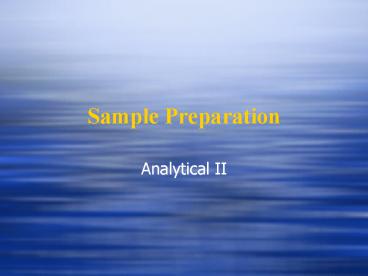Sample Preparation - PowerPoint PPT Presentation
1 / 13
Title:
Sample Preparation
Description:
Real samples require sample preparation to remove substances that interfere with ... Non oxidized acid is insufficient, aqua regia or other oxidized acids will work ... – PowerPoint PPT presentation
Number of Views:2569
Avg rating:3.0/5.0
Title: Sample Preparation
1
Sample Preparation
- Analytical II
2
Sampling
- Process of collecting a representative sample for
analysis. - Real samples require sample preparation to remove
substances that interfere with reading of the
analyte or convert the analyte into a suitable
form for analysis.
3
Statistics of Sampling
- For Random Error
- Overall variance, So2Sa2 Ss2
- Standard deviation in sampling operation
- ?n vnpq
- np expected number of particles
4
Choosing a Sample Size
- The bigger the sample the more sufficient your
sample will be and a decrease the in standard
deviation - Sampling Constant mR2Ks
- M is the mass of sample drawn
- R is the relative standard deviation (expressed
in percentage) - Ks is a sampling constant 36 g
5
Sampling a Random Bulk Material
- How many 0.7 g samples must be analyzed to give
95 confidence the the mean is known to within 4?
6
Dissolving Sample for Analysis
- Once the bulk sample is selected, a laboratory
sample must be prepared for analysis. - Solids are typically dried at 110oC, to remove
absorbed water prior to analysis - Dissolve sample for analysis
- If sample does not dissolve, acid digestion or
fusion may be used. - Organic material may be destroyed by combustion
7
Grinding
- Solids can be ground in a mortar and pestle
- The mortar is the base and the pestle is the
grinding tool - Ores and minerals can be crushed by striking the
pestle lightly - Boron Carbide- is the best mortar
8
Dissolving Inorganic Materials with Acids
- Insoluble inorganic materials can be dissolved in
strong acids and heating - Glass vessels are often useful, but Teflon,
platinum, or silver are required for HF, which
dissolves silicates. - Non oxidized acid is insufficient, aqua regia or
other oxidized acids will work - Teflon- lined bomb heated in a microwave oven
9
Dissolving Inorganic materials by Fusion
- If Acid digestion fails, fusion in a molten salt
will work - Large quantity of flux adds trace impurities
- This is a last resort procedure
10
Decomposition of Organic Substances
- Organic material are decomposed by wet ashing
with hot concentrated acids or dry ashing with
heat - Wet ashing- when water is involved
- Dry ashing- procedure does not involve water
11
Sampling Preparation Techniques
- Analytes can be seperated from complex matrices
samples by - Liquid extraction
- Analyte is dissolved in a solvent that does not
necessarily dissolve the entire sample and does
not decompose the analyte. - The liquid is then analyzed by chromatography
- Supercritical fluid extraction
- Superficial fluid as the extraction solvent
19CO2 - Solid- phase extraction
- Concentrates nonionic analytes
12
Preconcentration
- Metal ions can be preconcentrated with cation-
exchange resin - Trace analysis often requires preconcentration of
analyte to bring it to a higher concentration
prior to analysis
13
Derivatization
- Procedure in which analyte is chemically modified
to make it easier to detect or separate. - Ex. Aldehydes or ketones can be trapped and
derivatized by passing air through a tiny
cartridge containing 0.35g silica coated with 0.3
wt 2,4- dinitrophenylhydrazine.































